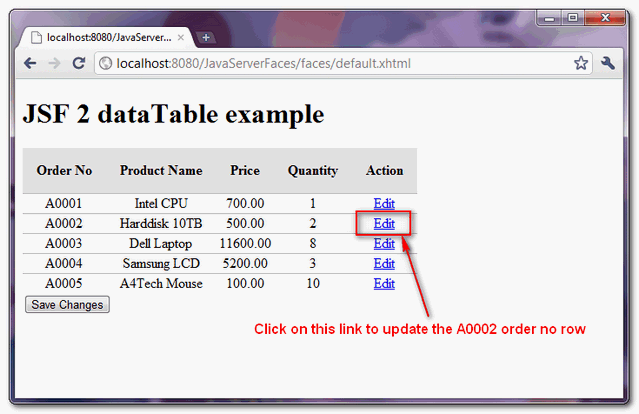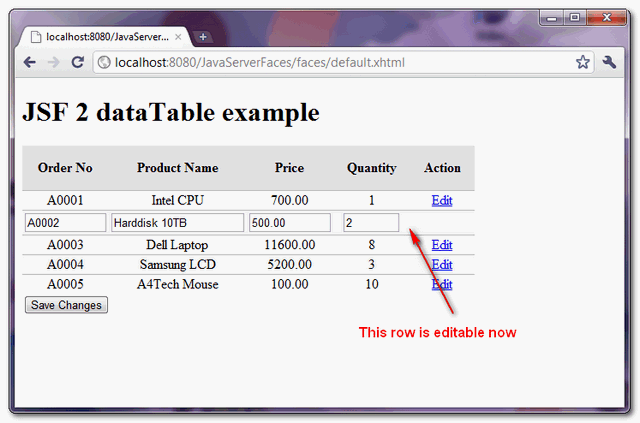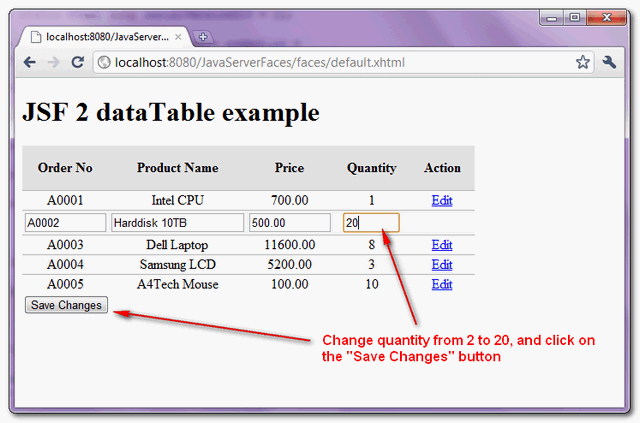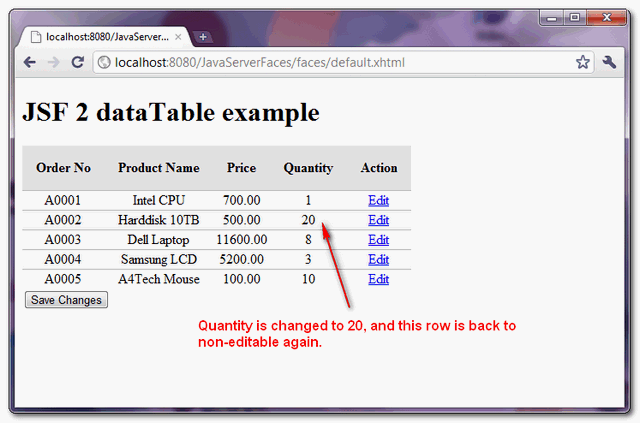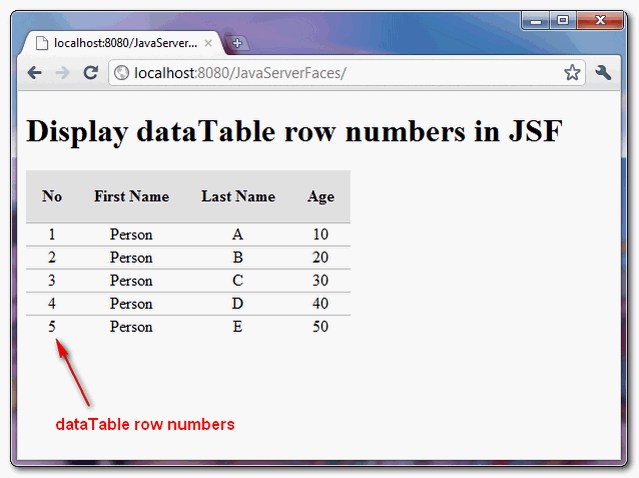Here’s the idea to sort a JSF dataTable list :

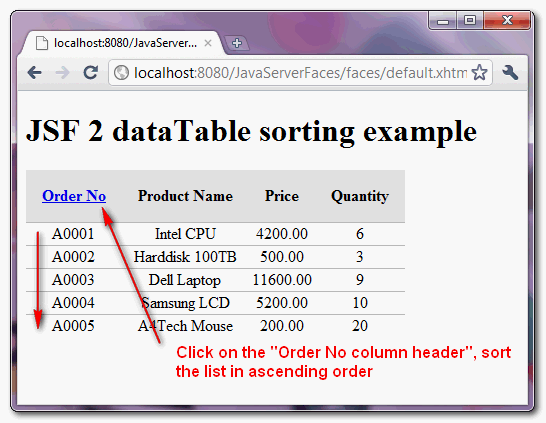
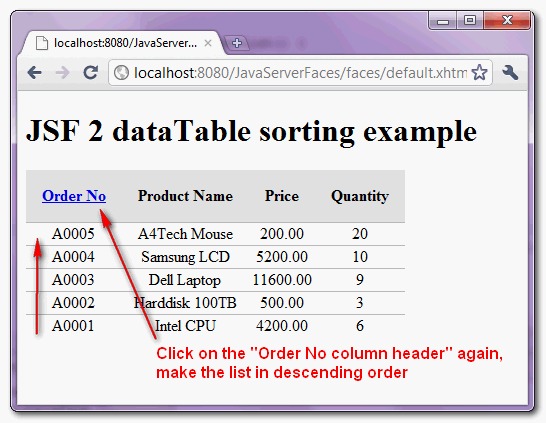
1. Column Header
Put a commandLink in the column header, if this link is clicked, sort the dataTable list.<h:column> <f:facet name="header"> <h:commandLink action="#{order.sortByOrderNo}"> Order No </h:commandLink> </f:facet> #{o.orderNo} </h:column>
2. Implementation
In the managed bean, uses Collections.sort() and custom comparator to sort the list.@ManagedBean(name="order") @SessionScoped public class OrderBean implements Serializable{ //sort by order no public String sortByOrderNo() { Collections.sort(orderArrayList, new Comparator<Order>() { @Override public int compare(Order o1, Order o2) { return o1.getOrderNo().compareTo(o2.getOrderNo()); } }); } //... }
dataTable Sorting example
A JSF 2.0 example to implement the sorting feature in dataTable. Click on the “Order No” column header make the list order by “Order No” in ascending order; Click it again, make the list order by “Order No” in descending order.1. Managed Bean
A managed bean to provide a dummy list for testing, and shows the use of Collections.sort() to sort the dataTable list.package com.mkyong; import java.io.Serializable; import java.math.BigDecimal; import java.util.ArrayList; import java.util.Arrays; import java.util.Collections; import java.util.Comparator; import java.util.List; import javax.faces.bean.ManagedBean; import javax.faces.bean.SessionScoped; @ManagedBean(name="order") @SessionScoped public class OrderBean implements Serializable{ private static final long serialVersionUID = 1L; private List<Order> orderArrayList; private boolean sortAscending = true; private static final Order[] orderList = { new Order("A0002", "Harddisk 100TB", new BigDecimal("500.00"), 3), new Order("A0001", "Intel CPU", new BigDecimal("4200.00"), 6), new Order("A0004", "Samsung LCD", new BigDecimal("5200.00"), 10), new Order("A0003", "Dell Laptop", new BigDecimal("11600.00"), 9), new Order("A0005", "A4Tech Mouse", new BigDecimal("200.00"), 20) }; public OrderBean(){ orderArrayList = new ArrayList<Order>(Arrays.asList(orderList)); } public List<Order> getOrderList() { return orderArrayList; } //sort by order no public String sortByOrderNo() { if(sortAscending){ //ascending order Collections.sort(orderArrayList, new Comparator<Order>() { @Override public int compare(Order o1, Order o2) { return o1.getOrderNo().compareTo(o2.getOrderNo()); } }); sortAscending = false; }else{ //descending order Collections.sort(orderArrayList, new Comparator<Order>() { @Override public int compare(Order o1, Order o2) { return o2.getOrderNo().compareTo(o1.getOrderNo()); } }); sortAscending = true; } return null; } public static class Order{ String orderNo; String productName; BigDecimal price; int qty; public Order(String orderNo, String productName, BigDecimal price, int qty) { this.orderNo = orderNo; this.productName = productName; this.price = price; this.qty = qty; } public String getOrderNo() { return orderNo; } public void setOrderNo(String orderNo) { this.orderNo = orderNo; } public String getProductName() { return productName; } public void setProductName(String productName) { this.productName = productName; } public BigDecimal getPrice() { return price; } public void setPrice(BigDecimal price) { this.price = price; } public int getQty() { return qty; } public void setQty(int qty) { this.qty = qty; } } }
2. dataTable Tag
A JSF page, put a commandLink tag in the “Order No” column header, if click, sort the dataTable list.<?xml version="1.0" encoding="UTF-8"?> <!DOCTYPE html PUBLIC "-//W3C//DTD XHTML 1.0 Transitional//EN" "http://www.w3.org/TR/xhtml1/DTD/xhtml1-transitional.dtd"> <html xmlns="http://www.w3.org/1999/xhtml" xmlns:h="http://java.sun.com/jsf/html" xmlns:f="http://java.sun.com/jsf/core" xmlns:c="http://java.sun.com/jsp/jstl/core" > <h:head> <h:outputStylesheet library="css" name="table-style.css" /> </h:head> <h:body> <h1>JSF 2 dataTable sorting example</h1> <h:form> <h:dataTable value="#{order.orderList}" var="o" styleClass="order-table" headerClass="order-table-header" rowClasses="order-table-odd-row,order-table-even-row" > <h:column> <f:facet name="header"> <h:commandLink action="#{order.sortByOrderNo}"> Order No </h:commandLink> </f:facet> #{o.orderNo} </h:column> <h:column> <f:facet name="header"> Product Name </f:facet> #{o.productName} </h:column> <h:column> <f:facet name="header">Price</f:facet> #{o.price} </h:column> <h:column> <f:facet name="header">Quantity</f:facet> #{o.qty} </h:column> </h:dataTable> </h:form> </h:body> </html>
3. Demo
From top to bottom, shows a dataTable list being sorted in ascending and descending order.


Download Source Code
Download It – JSF-2-DataTable-Sorting-Example.zip (10KB)

